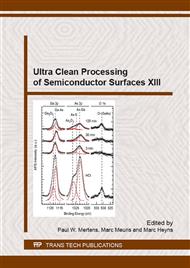p.3
p.8
p.13
p.18
p.22
p.27
p.31
p.36
Silicon Surface Passivation in HF Solutions for Improved Gate Oxide Reliability
Abstract:
The silicon surface passivation with diluted HF solutions is hereby explained. Without a very stable, correct Si-H surface passivation, a rough silicon surface can be obtained, leading to poor gate oxide integrity or bad epi film quality. Detailed mechanism are depicted and solutions to obtain best Si-H passivated surface are given
Info:
Periodical:
Pages:
8-12
Citation:
Online since:
September 2016
Authors:
Price:
Сopyright:
© 2016 Trans Tech Publications Ltd. All Rights Reserved
Share:
Citation:


